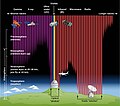Atmosphere of Earth
Atmosphere of Earth is the layer of gases, commonly known as air, that surrounds the Earth and is retained by Earth's gravity. The atmosphere of Earth protects life on Earth by creating pressure allowing for liquid water to exist on the Earth's surface, absorbing ultraviolet solar radiation, warming the surface through heat retention (greenhouse effect), and reducing temperature extremes between day and night (the diurnal temperature variation).
Composition[edit]
The atmosphere of Earth is a mixture of nitrogen (about 78%), oxygen (about 21%), argon (about 0.9%), carbon dioxide (0.04%) and other gases in trace amounts. Water vapor also is a significant constituent of Earth's atmosphere, though it varies in concentration from 0% in the cold polar regions to almost 4% in the tropics.
Structure[edit]
The atmosphere of Earth can be divided into five main layers. These are, from nearest to farthest from the Earth's surface:
- The Troposphere
- The Stratosphere
- The Mesosphere
- The Thermosphere
- The Exosphere
Weather and Climate[edit]
The weather and climate of Earth are driven by the atmospheric conditions. Weather refers to short-term changes in atmospheric conditions, while climate refers to long-term patterns.
Importance to Life[edit]
The atmosphere of Earth is vital for life as it provides oxygen for humans and animals to breathe, carbon dioxide for plants to photosynthesize, and protects life from harmful levels of solar radiation and cosmic rays.
See Also[edit]
-
Atmosphere of Earth
-
Atmosphere of Earth
-
Atmosphere of Earth
-
Atmosphere of Earth
-
Atmosphere of Earth
-
Atmosphere of Earth
-
Atmosphere of Earth
-
Atmosphere of Earth
-
Atmosphere of Earth
-
Atmosphere of Earth
-
Atmosphere of Earth
-
Atmosphere of Earth
Ad. Transform your life with W8MD's Budget GLP-1 injections from $75


W8MD offers a medical weight loss program to lose weight in Philadelphia. Our physician-supervised medical weight loss provides:
- Weight loss injections in NYC (generic and brand names):
- Zepbound / Mounjaro, Wegovy / Ozempic, Saxenda
- Most insurances accepted or discounted self-pay rates. We will obtain insurance prior authorizations if needed.
- Generic GLP1 weight loss injections from $75 for the starting dose.
- Also offer prescription weight loss medications including Phentermine, Qsymia, Diethylpropion, Contrave etc.
NYC weight loss doctor appointmentsNYC weight loss doctor appointments
Start your NYC weight loss journey today at our NYC medical weight loss and Philadelphia medical weight loss clinics.
- Call 718-946-5500 to lose weight in NYC or for medical weight loss in Philadelphia 215-676-2334.
- Tags:NYC medical weight loss, Philadelphia lose weight Zepbound NYC, Budget GLP1 weight loss injections, Wegovy Philadelphia, Wegovy NYC, Philadelphia medical weight loss, Brookly weight loss and Wegovy NYC
|
WikiMD's Wellness Encyclopedia |
| Let Food Be Thy Medicine Medicine Thy Food - Hippocrates |
Medical Disclaimer: WikiMD is not a substitute for professional medical advice. The information on WikiMD is provided as an information resource only, may be incorrect, outdated or misleading, and is not to be used or relied on for any diagnostic or treatment purposes. Please consult your health care provider before making any healthcare decisions or for guidance about a specific medical condition. WikiMD expressly disclaims responsibility, and shall have no liability, for any damages, loss, injury, or liability whatsoever suffered as a result of your reliance on the information contained in this site. By visiting this site you agree to the foregoing terms and conditions, which may from time to time be changed or supplemented by WikiMD. If you do not agree to the foregoing terms and conditions, you should not enter or use this site. See full disclaimer.
Credits:Most images are courtesy of Wikimedia commons, and templates, categories Wikipedia, licensed under CC BY SA or similar.
Translate this page: - East Asian
中文,
日本,
한국어,
South Asian
हिन्दी,
தமிழ்,
తెలుగు,
Urdu,
ಕನ್ನಡ,
Southeast Asian
Indonesian,
Vietnamese,
Thai,
မြန်မာဘာသာ,
বাংলা
European
español,
Deutsch,
français,
Greek,
português do Brasil,
polski,
română,
русский,
Nederlands,
norsk,
svenska,
suomi,
Italian
Middle Eastern & African
عربى,
Turkish,
Persian,
Hebrew,
Afrikaans,
isiZulu,
Kiswahili,
Other
Bulgarian,
Hungarian,
Czech,
Swedish,
മലയാളം,
मराठी,
ਪੰਜਾਬੀ,
ગુજરાતી,
Portuguese,
Ukrainian














